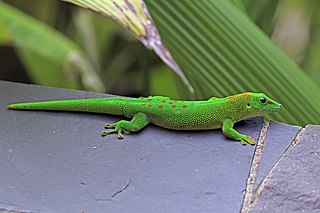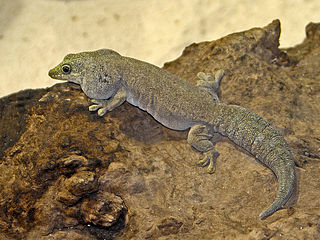
Phelsuma is a large genus of geckos in the family Gekkonidae. Species in the genus Phelsuma are commonly referred to as day geckos.

Phelsuma astriata astriata is a subspecies of Seychelles small day gecko. It is a small, slender lizard with bright green colour that feeds primarily on insects. It is found on several islands of the Seychelles.

Barbour's day gecko is a species of lizard in the family Gekkonidae. The species is endemic to central Madagascar. It is diurnal and typically dwells on rocks. Barbour's day gecko feeds on insects and nectar.

The blue-tailed day gecko is a diurnal species of gecko, a lizard in the family Gekkonidae. The species is endemic to the island Mauritius. It typically inhabits warm and humid places and dwells on different trees and bushes.

Phelsuma dubia, also known as dull day gecko, olive day gecko, Zanzibar day gecko or green day gecko, is a diurnal species of gecko. It is about 15 centimetres (5.9 in) in length and lives on the western coast of Madagascar, in the Comoros, and the coast of East Africa. It typically inhabits trees and can also be found near human dwellings. The Dull day gecko feeds on insects and nectar.
Agalega day gecko is a subspecies of geckos.
The Rodrigues giant day gecko is an extinct species of day gecko. It lived on the island of Rodrigues and surrounding islands and typically dwelt on trees. The Rodrigues giant day gecko fed on insects and nectar, and, unlike most other day geckos, was apparently nocturnal in habit.

The Round Island day gecko, also known commonly as Günther's gecko, is an endangered species of lizard in the family Gekkonidae. The species is endemic to the islet Round Island, Mauritius, and typically dwells on palm trees. The Round Island day gecko feeds on insects and nectar.

The speckled day gecko is a diurnal species of geckos. It lives in eastern Madagascar and typically inhabits rainforests and dwells on trees. The speckled day gecko feeds on insects and nectar.

The gold dust day gecko is a diurnal species of gecko. It lives in northern Madagascar, Tanzania and on the island of Comoros; it has also been introduced to Hawaii and other Pacific islands. It's typically seen in houses and various trees. The gold dust day gecko feeds on insects and nectar.

Phelsuma grandis is a diurnal arboreal species of day gecko. These geckos are part of the Phelsuma group, which consists of in excess of 70 species and subspecies. They are commonly referred to as the Madagascar giant day gecko, due to their large size. They are native to areas of tropical and subtropical forest in northern Madagascar, but have been introduced to several other subtropical locations outside their range. P. grandis feeds on various invertebrates, very small vertebrates, and nectars. It is bred and sold as an exotic pet.

The flat-tailed day gecko is a diurnal gecko lives in eastern Madagascar. It is endangered due to illegal collection for the international pet trade. It typically inhabits rainforests and dwells on trees. The flat-tailed day gecko feeds on insects and nectar.

Standing's day gecko is an arboreal and diurnal species of lizard in the family Gekkonidae. The species is endemic to southwest Madagascar; it is threatened by illegal collection for the international pet trade and habitat loss. It is among the largest living species of day geckos. Standing's day gecko feeds on insects and nectar.

Seipp's day gecko is an endangered diurnal species of lizard in the family Gekkonidae. The species is native to northern Madagascar, typically inhabits rainforests, dwells on trees, and feeds on insects and nectar.

Pasteur's day gecko is a small diurnal subspecies of gecko. It lives in the Comoros and typically inhabits trees and bushes. Pasteur's day gecko feeds on insects and nectar.

The Anjouan Island day gecko is a small diurnal subspecies of gecko. It lives in the Comoros and typically inhabits trees and bushes. The Anjouan Island day gecko feeds on insects and nectar.

Seychelles giant day gecko is diurnal subspecies of geckos. It lives on the island Praslin in the Seychelles and typically inhabits trees and dwellings. The Seychelles giant day gecko feeds on insects and nectar.

Phelsuma sundbergi ladiguensis is a diurnal subspecies of Phelsuma sundbergi. It lives on the islands Ladigue, Felicite and Cocco in the Seychelles, and typically inhabits trees and dwellings. The Seychelles giant day gecko feeds on insects and nectar.

Mahé day gecko is a diurnal subspecies of geckos. It lives on the western granite islands of the Seychelles and typically inhabits trees and human dwellings. The Seychelles giant day gecko feeds on insects and nectar.
Phelsuma parkeri, commonly known as Parker's day gecko or the Pemba Island day gecko, is a diurnal species of lizard in the family Gekkonidae. The species is endemic to Pemba Island, Tanzania, and typically inhabits banana trees and dwellings. The Pemba Island day gecko feeds on insects and nectar.





















